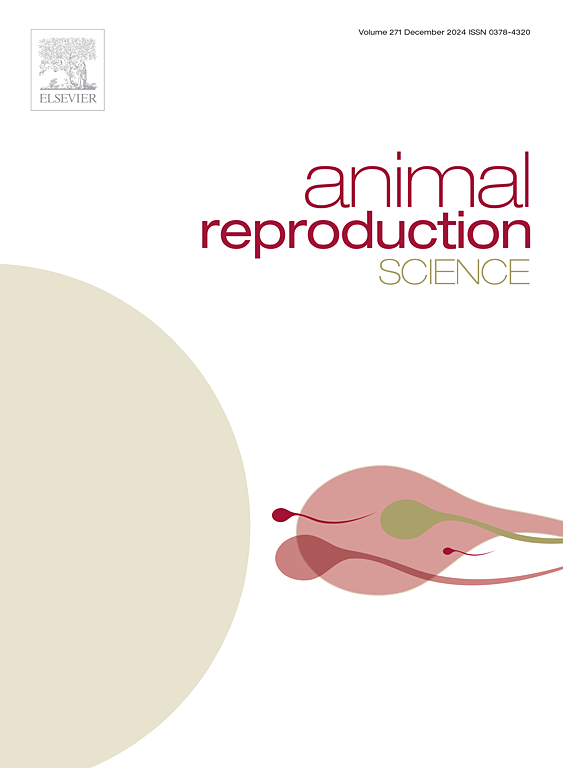宫内生长限制破坏后备母猪卵泡发生:对生殖健康的见解
IF 3.3
2区 农林科学
Q1 AGRICULTURE, DAIRY & ANIMAL SCIENCE
引用次数: 0
摘要
宫内生长受限(IUGR)被定义为胎儿未达到其全部生长潜力并在以后的生活中造成严重后果的一种情况。本研究采用组织形态学分析的方法,对正常体重(NW)和IUGR母猪的卵泡发育进行了评价。选取50对刚出生的雏母猪,按出生体重分为IUGR(0.8 ~ 1.0 kg)和NW(1.4 ~ 1.7 kg) 2个试验组。安乐死分三个阶段进行:出生、100天和150天,在此期间测量身体和器官重量,固定卵巢并进行组织形态学评估。取150日龄动物第三次卵泡面积,按大小分类。IUGR新生雌鼠肝、脑重量较轻,脑/肝重量比较高(P <; 0.05),证实其存在宫内生长受限。此外,IUGR母猪在100日龄和150日龄时体重较低(P <; 0.05),与NW母猪相比,显示出身体发育受损。IUGR动物在100天时原始卵泡数较高,150天时闭锁卵泡数较低(P <; 0.05)。IUGR女性的成熟卵泡数量也略有减少,为0.31-0.6 mm2 (P = 0.07)。总的来说,IUGR会影响卵泡的发生,因为卵泡的补充和选择减少,这表明这些动物在以后的生活中可能会有较差的生殖表现,不应该被选择进入繁殖群。本文章由计算机程序翻译,如有差异,请以英文原文为准。
Intrauterine growth restriction disrupts folliculogenesis in gilts: Insights into reproductive health
Intrauterine growth restriction (IUGR) is defined as a condition in which the fetus does not reach its full growth potential with serious consequences later in life. This study evaluated, by means of histomorphometrical analysis, the follicular development in normal weight (NW) and IUGR gilts along postnatal development. Fifty pairs of littermate gilts were selected at birth and allocated into two experimental groups according to birthweight: IUGR (0.8–1.0 kg) and NW (1.4–1.7 kg). Euthanasia was performed at three stages: birth, 100 days, and 150 days of age, when body and organ weights were measured, and the ovaries fixed and processed for histomorphometrical evaluation. Follicle area of tertiary follicles from 150-day-old animals were obtained and classified according to size. IUGR newborn females presented lighter liver and brain, as well as a higher brain/liver weight ratio (P < 0.05), confirming that these females suffered intrauterine growth restriction. Moreover, IUGR gilts showed lower body weights at 100 and 150 days of age (P < 0.05), demonstrating impaired body development compared to their NW littermates. IUGR animals presented higher number of primordial follicles at 100 days and lower number of atretic follicles at 150 days (P < 0.05). IUGR females also showed a slight reduction in the number of mature follicles measuring 0.31–0.6 mm2 (P = 0.07). Collectively, IUGR impacts folliculogenesis due to the reduction in follicular recruitment and selection, suggesting that these animals may have poor reproductive performance later in life and should not be selected to enter the breeding herd.
求助全文
通过发布文献求助,成功后即可免费获取论文全文。
去求助
来源期刊

Animal Reproduction Science
农林科学-奶制品与动物科学
CiteScore
4.50
自引率
9.10%
发文量
136
审稿时长
54 days
期刊介绍:
Animal Reproduction Science publishes results from studies relating to reproduction and fertility in animals. This includes both fundamental research and applied studies, including management practices that increase our understanding of the biology and manipulation of reproduction. Manuscripts should go into depth in the mechanisms involved in the research reported, rather than a give a mere description of findings. The focus is on animals that are useful to humans including food- and fibre-producing; companion/recreational; captive; and endangered species including zoo animals, but excluding laboratory animals unless the results of the study provide new information that impacts the basic understanding of the biology or manipulation of reproduction.
The journal''s scope includes the study of reproductive physiology and endocrinology, reproductive cycles, natural and artificial control of reproduction, preservation and use of gametes and embryos, pregnancy and parturition, infertility and sterility, diagnostic and therapeutic techniques.
The Editorial Board of Animal Reproduction Science has decided not to publish papers in which there is an exclusive examination of the in vitro development of oocytes and embryos; however, there will be consideration of papers that include in vitro studies where the source of the oocytes and/or development of the embryos beyond the blastocyst stage is part of the experimental design.
 求助内容:
求助内容: 应助结果提醒方式:
应助结果提醒方式:


